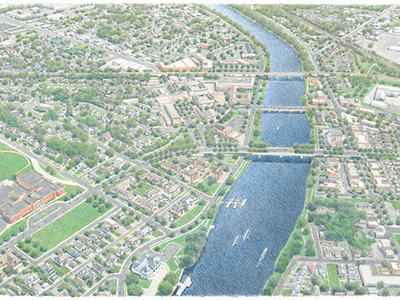
Just northwest of the thriving South Bend Farmers Market, there is a tangle of cloverleaf interchanges — hulking remnants from a 1960s urban renewal project — that would seem more appropriate for a toll road than a residential and small-business neighborhood in the heart of South Bend, Indiana.
Originally designed to hasten workers’ commutes to downtown and service the city’s Studebaker factory, these freeway-like ramps onto Eddy Street not only severed local neighborhoods from the river, but also decimated local retail.
The long-lasting ramifications of urban renewal projects like this one are apparent in cities across the United States, said Marianne Cusato, professor of the practice in the University of Notre Dame’s School of Architecture, and disproportionately impact minority and low-income communities.
Developing a plan to repair the damage is a complex endeavor, but Notre Dame is leading the charge.
Stefanos Polyzoides, the Francis and Kathleen Rooney Dean of Architecture, has appointed Cusato director of a new School of Architecture initiative on housing and community regeneration. Together, they are working with business and community leaders in South Bend and Kalamazoo, Michigan, to restore and revitalize neighborhoods.
Their efforts contributed to the city of South Bend being awarded a $2.4 million federal infrastructure grant this month to finalize research and planning for the removal of the cloverleaf interchanges. In addition, they are supporting the efforts of the city of Kalamazoo, which received $6 million in federal funding earlier in August to implement a plan to make its downtown streets more pedestrian-friendly.
“It is very encouraging that the federal government is supporting projects that intend to transform car-oriented streets to multi-modal ones with an emphasis on walkability,” Polyzoides said. “Our regional projects for repairing and constructing walkable, mixed-use, compact and diverse cities are the best possible response to climate change.”

The design process for the farmers market district began in October 2021 with an intense, weeklong planning session led by Polyzoides and Cusato. Local business owners, community leaders, architectural professionals and Notre Dame students all gathered to participate in the process, known as a Dean’s Charrette. A charrette involves professional teams from a variety of disciplines working to solve particular issues with continuous feedback from all stakeholders.
“We start beforehand by inviting property owners to listening sessions to understand their needs and concerns,” Cusato said. “Then, during these few days, we work on ideas, test them, get feedback and adjust them. Because you have an immediate feedback loop, you can take months out of the process. And at the end of the week, you have a design proposal that allows the city to highlight its priorities.”
In addition to removing the aging infrastructure on Eddy Street, some of the cornerstone ideas to emerge included engaging with the riverfront through an enhanced riverside walk, supporting new and legacy businesses by drawing activity to the area and attracting mixed-use development over time by introducing new residences, businesses and a high-quality public realm of parks and streets. To allow cities flexibility, the ideas in the final report are designed to work together or stand alone.
In addition to studying the farmers market district, the School of Architecture has also conducted a charrette in South Bend’s William Street neighborhood and just completed its third charrette in Kalamazoo last week.
In each area, there are common problems — like streets that are dangerous and unwelcoming for pedestrians. Solving that issue is essential to fighting climate change, Cusato said.
“The climate change discussion typically only focuses on solutions that treat the symptoms, not the disease. ... The disease isn’t a gas-guzzling car, it’s the road. It’s the settlement pattern that requires someone to drive to meet all of their daily needs because there are no businesses within walking distance to one’s home or because the streets are unsafe for pedestrians.”
“The climate change discussion typically only focuses on solutions that treat the symptoms, not the disease,” she said. “Electric vehicles, solar panels, etc., are all ways to take the edge off the amount of energy we consume. But the disease isn’t a gas-guzzling car, it’s the road. It’s the settlement pattern that requires someone to drive to meet all of their daily needs because there are no businesses within walking distance to one’s home or because the streets are unsafe for pedestrians.
“The disease is the outdated and failed freeway-like infrastructure of ramps that divide communities and leave vacant land where there were once thriving businesses. This area needs a catalyst to regenerate the economy and attract new life, otherwise new development will continue to move further and further from the city center and consume more and more resources as residents live their daily lives.”
Going forward, the School of Architecture will continue to work with the city of South Bend on the farmers market district, building on the design concepts created during the charrette and — with the federal grant — helping to transform them into an engineered, shovel-ready project.
The team also plans to continue hosting charrettes in the region and hopes to eventually compile them into a publication as a series of case studies that will help other cities nationwide.
“When you look at what is happening in the Midwest, there are similarities everywhere that are inescapable,” Cusato said. “There is a housing crisis everywhere. There is failing infrastructure everywhere. These are universal issues, and we are in a very special moment in terms of planning — and building awareness of how zoning plays into climate and social problems.
“Our society is ready to see the activation of underutilized areas of our cities. This is what we’re trying to do with our work — we want to help cities articulate and develop a vision for their communities that finds value in places left behind by time.”